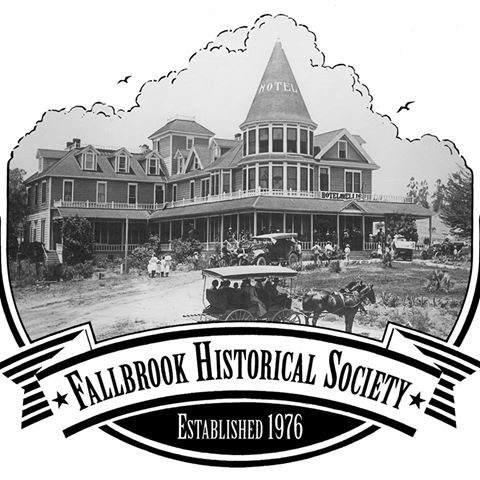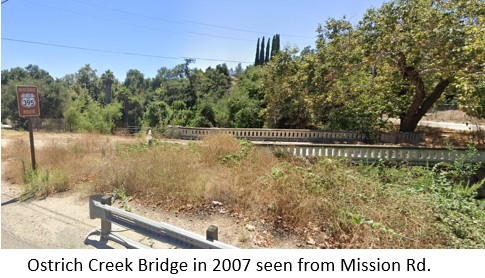The Ostrich Creek Bridge is a designated San Diego County Historic Site. Because the Ostrich Creek Bridge is part of the transportation theme of Fallbrook’s history, the Fallbrook Historical Society researched the bridge’s history and applied for the designation.
Built about 1925, the Ostrich Creek Bridge is located 2 and ½ miles south of Fallbrook where Overland Trail meets Mission Road. Native American artifacts and grinding holes from a prehistoric milling site have been found in Ostrich Creek.
In 1921, the California Legislature had passed a bill establishing a State highway between Riverside and San Diego, and would become known as the “Mission Trail” (later it became U.S. 395). The County began making improvements – acquiring easements, widening and realigning the roadbed along the proposed route. Eventually paving could begin and new bridges built. Under the State highway program, the site of crossing Ostrich Creek was moved 500 feet south to take advantage of the granite foundation rock. U.S. 395 and the Ostrich Creek Bridge would enable Fallbrook to survive the Great Depression of the next decade.
Prior to and during World War II, every vehicle that wanted to go from San Diego to points north on the inland route had to pass over this bridge. Jack Story of the Fallbrook Historical Society, who grew up nearby reported, “The bridge was so narrow that if two large vehicles tried to pass, there would only be room for onion skins between them.”
In the 1940s, after the U.S. Government bought the Santa Margarita Ranch to develop Camp Pendleton, and the Naval Ammunition Depot, U.S. 395 became important as a military highway. Many convoys of Marines and ammunition passed over this bridge on their way to ships in port at San Diego. Mission Road bypasses this bridge now. Protected, it is no longer used by traffic.
The Fallbrook Historical Society had been concerned that the bridge might be declared surplus and demolished in some future highway project. Historian Elizabeth Hughes Yamaguchi, grew up on nearby Hughes Lane. Her mother’s popular Silver Springs café was another landmark of Highway 395. Yamaguchi led the research summarized here and applied for historic protection under Sections 5700 – 5747 of the County Zoning Ordinance. The Board of Supervisors designated it a County Historic Site in 1992. The Department of Public Works then put concrete barriers at each end of the bridge, so it could no longer be used by vehicular traffic.
Tom Frew
FHS Historian


